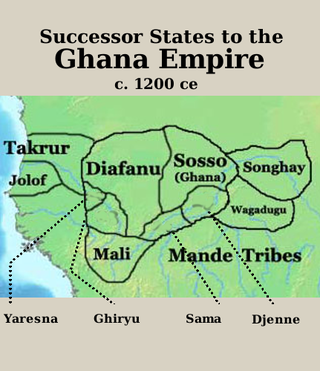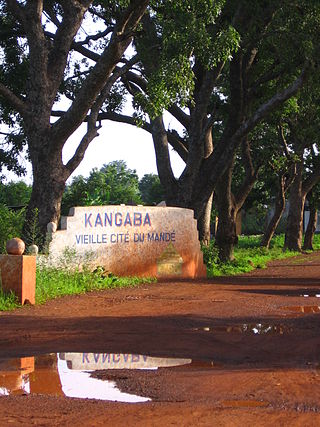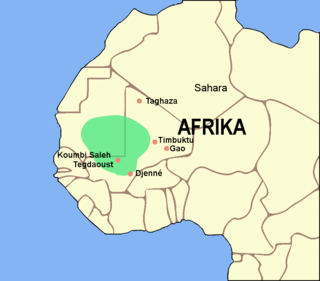
The Mali Empire was an empire in West Africa from c. 1226 to 1670. The empire was founded by Sundiata Keita and became renowned for the wealth of its rulers, especially Mansa Musa. At its peak, Mali was the largest empire in West Africa, widely influencing the culture of the region through the spread of its language, laws, and customs.

The balafon is a gourd-resonated xylophone, a type of struck idiophone. It is closely associated with the neighbouring Mandé, Senoufo and Gur peoples of West Africa, particularly the Guinean branch of the Mandinka ethnic group, but is now found across West Africa from Guinea to Mali. Its common name, balafon, is likely a European coinage combining its Mandinka name ߓߟߊ bala with the word ߝߐ߲ fôn 'to speak' or the Greek root phono.
Sundiata Keita was a prince and founder of the Mali Empire. He was also the great-uncle of the Malian ruler Mansa Musa, who is usually regarded as the wealthiest person of all time, although there are no reliable ways to accurately calculate his wealth.
The Mandé people are an ethnic and linguistic group who are native to West Africa, possessing a long shared history and forming a distinct linguistic family known as the Mandé Languages. The Mandé languages are divided into two primary groups: East Mandé and West Mandé.
Naré Maghann Konaté was a 12th-century faama (king) of the Mandinka people, in what is today Mali and the progenitor of the Maghan people of Ghana. He was the father of Sundiata Keita, founder of the Mali Empire, and a character in the oral tradition of the Epic of Sundiata.

Soumaoro Kanté was a 13th-century king of the Sosso people. Seizing Koumbi Saleh, the capital of the recently defunct Ghana Empire, Soumaoro Kanté proceeded to conquer several neighboring states, including the Mandinka people in what is now Mali. However, the Mandinka prince Sundiata Keita built a coalition of smaller kingdoms to oppose him at the Battle of Kirina, defeating the Sosso and leaving Sundiata's new Mali Empire dominant in the region.
The Battle of Kirina, also known as the Battle of Krina or siege of Karina, was a confrontation between Sosso king Sumanguru Kanté and Mandinka prince Sundiata Keita. Sundiata Keita's forces roundly defeated those of Sumanguru Kanté, guaranteeing the pre-eminence of Keita's new Mali Empire over West Africa.
Sunjata is an epic poem of the Malinke people that tells the story of the hero Sundiata Keita, the founder of the Mali Empire. The epic is an instance of oral tradition, going back to the 13th century and narrated by generations of griot poets or jeliw (djeli). There is no single or authoritative version. Material pertaining to the epic first began to be collected during the early 20th century in French Sudan, notably by the French elite school École William Ponty, resulting in the "modern" version of the tale as considered standard today, based on the oral account by Djeli Mamoudou Kouyate, a griot or traditional oral historian, translated into French by Djibril Tamsir Niane in 1960.

Siby is a village and rural commune in the Cercle of Kati in the Koulikoro Region of southern Mali. The commune contains 21 villages and in the 2009 census had a population of 26,632. The village lies 50 km southwest of the capital, Bamako, on the plain to the south of the Monts Mandingues. The RN5 road that links Bamako with Siguiri in Guinea runs through the village.

The Susu people are a Mande-speaking ethnic group living primarily in Guinea and Northwestern Sierra Leone, particularly in Kambia District. Influential in Guinea, smaller communities of Susu people are also found in the neighboring Guinea-Bissau and Senegal.
The Twelve Doors of Mali were the possessions of the Mansa (emperor) of the medieval Mali Empire which was established in c.. 1235 following The Battle of Kirina. These lands were either allied to or conquered by Sundiata Keita on his campaign to free the Mandinka heartland from the Sosso kingdom of Kaniaga.

The Yalunka, or Dialonké, are a Mandé-speaking people and the original inhabitants of Futa Jallon, a mountainous region in Guinea, West Africa. The Yalunka people live primarily in Guinea, particularly in Faranah, while smaller communities are found in Kouroussa. Additional Yalunka are also located in northeastern Sierra Leone, southeastern Senegal, and southwestern Mali.

Pre-imperial Mali refers to the period of history before the establishment of the Mali Empire, an African empire located mostly in present-day Mali, in c. 1235.

Kangaba is a town, commune, and seat of the Kangaba Cercle in the Koulikoro Region of south-western Mali.

The Ghana Empire, also known as simply Ghana, Ghanata, or Wagadou, was a West African classical to post-classical era western-Sahelian empire based in the modern-day southeast of Mauritania and western Mali.
Dankaran Touman was the first son of Naré Maghann Konaté in the Malian epic of Sundiata. He was also the King of Manden prior to the establishment of the Mali Empire.
Méma is a region in Mali, Africa. A plain of alluvial deposits, it is situated north of Massina; west of Lake Debo and the Inner Niger Delta; and southwest of the Lakes Region. The now-senescent basin may have been the first settlement area for communities who migrated from distressed homelands of the Sahara during the last two millennia BC.

Manding, Manden or even Mandé is a region located in West Africa, a space between southern Mali and eastern Guinea. It is the historic home of the Mandinka community.
Diarra, also referred to as Kingui or Kaniaga was a Soninke state in what is now northwestern Mali, centered around the town of Diarra.
Sogolon Wulen Condé of Dò ni Kiri, commonly known as Sogolon Condé, was a 13th-century princess of Imperial Mali, and one of the prominent women portrayed in the Epic of Sundiata. Her trials and tribulations are well preserved in the epic. She was the second wife of Faama (King) Naré Maghann Konaté, and mother of Mansa Sundiata Keita, founder of the Mali Empire in the 13th century. According to Bamba Suso and Banna Kanute, Sogolong's father was Sankarang Madiba Konte, also known as Faa Ganda, a descendant of Khulubu Konte. In the epic, Sogolon is portrayed as the daughter of the "buffalo woman" –so-called because of her "ugliness" and hunchback, and so was Sogolong. The griots of Guinea refer to Sogolon as the younger sister of Do Kamissa. In many parts of the Senegambia region, and Mali, Sogolon is regarded as her daughter. As well as her physical deformities and "ugliness", Sogolon also gave birth to a disabled son (Sundiata), and was ridiculed for that. Following the death of her husband Naré Maghann Konaté, her co-wife, the politically ambitious Sassouma Bereté, Naré Maghann's first wife along with their first son Dankaran Toumani Keïta, plotted against Sogolon and her children, including assassination attempts on their lives. Fearing that the new King Dankaran and his mother Sassouma could inflict harm upon her and her children, Sogolon went into exile with her children to protect them from harm. Due to the power and influence of Dankaran and his mother, Sogolon and her children were refused asylum by many states within the Ghana Empire they traversed seeking protection. She was eventually granted asylum by the King of Mema Mansa Farin Tunkara. In Mema, Sogolon encouraged his disabled son Sundiata to fulfill his destiny, and return to Mali (Manden) and take the throne.









